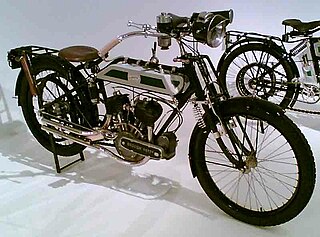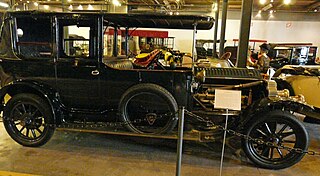Related Research Articles

A flat-twin engine is a two-cylinder internal combustion engine with the cylinders on opposite sides of the crankshaft. The most common type of flat-twin engine is the boxer-twin engine, where both pistons move inwards and outwards at the same time.
The Adamson was an English car manufactured in Enfield, Middlesex, from 1912 to 1925. It was designed by Reginald Barton Adamson at the premises of the family haulage contract business.

De Dion-Bouton was a French automobile manufacturer and railcar manufacturer operating from 1883 to 1953. The company was founded by the Marquis Jules-Albert de Dion, Georges Bouton, and Bouton's brother-in-law Charles Trépardoux.

BMC ADO17 is the model code used by the British Motor Corporation (BMC) for a range of large family cars manufactured from September 1964 to 1975. The car was initially sold under the Austin marque as the Austin 1800, then by Morris as the Morris 1800, by Wolseley as the Wolseley 18/85, and later the Austin 2200, Morris 2200 and Wolseley Six. The 1800 was voted European Car of the Year for 1965.

Trojan was a British automobile manufacturer producing light cars between 1914 and 1965, and light commercial vehicles for a short time.

Brough Motorcycles were made by William E. Brough in Nottingham, England, from 1902 to 1926, after some earlier experimentation with motorised tricycles. The Brough Superior company was a separate company created by his son, George Brough.
Lloyd Cars Ltd was a British motor manufacturer, founded by Roland Lloyd (1904–1965), son of a garage owner, and based in Patrick Street, Grimsby, Lincolnshire, England between 1936 and 1951. Two models were made, separated by World War II; the company was unusual for a small manufacturer in making nearly all components in-house. After car production ceased the company continued in general engineering until 1983. During World War II the company made components for Rolls-Royce Merlin aircraft engines.
Eshelman was a marque of small American automobiles (1953–1961) and other vehicles and implements including motor scooters, garden tractors, pleasure boats, aircraft, golf carts, snowplows, trailers, mail-delivery vehicles and more. The Cheston L. Eshelman Company was incorporated on January 19, 1942, and was based on the sixth floor of an industrial building at 109 Light Street in Baltimore, Maryland, with aircraft production facilities located in Dundalk, Maryland. The company president was Cheston Lee Eshelman, the first vice-president was Sidney S. Zell, and the first treasurer was Frank K. Kris.

Coventry Premier Limited owned a British car and cyclecar manufacturing business based in Coventry from 1912 to 1923. It changed its name from Premier Cycles to Coventry Premier Ltd in November 1914.
The Sheppee was an English steam automobile manufactured in York by the Sheppee Motor Company run by Colonel Francis Henry Sheppee, son of Lieutenant-Colonel Francis Faulkener Sheppee. After long service with the army in India, Colonel F.H. Sheppee created the Sheppee Motor Company in Thomas Street, York around 1902. The firm mainly made steam-driven commercial vehicles but in 1912 at least two passenger cars were made with 25 hp engines and flash boilers. In 1913, they announced they had got a site on the Birmingham Road near Worcester where they would build a new factory for production of their 3-ton steam wagons.

Douglas was a British motorcycle manufacturer from 1907 to 1957 based in Kingswood, Bristol, owned by the Douglas family, and especially known for its horizontally opposed twin cylinder engined bikes and as manufacturers of speedway machines. The company also built a range of cars between 1913 and 1922.
The following outline is provided as an overview of and topical guide to automobiles:
The Rover 8 was a small single-cylinder 8 hp 1327 cc car made by the British Rover car company. It was Rover's first production car. It was remarkable for being supported by a backbone chassis rather than a conventional ladder frame. The first model was manufactured from 1904 to 1912. A Daimler-Knight sleeve valve engine option was available on the original model in 1911 and 1912.

The Tamplin was an English automobile manufactured by Tamplin Motors from 1919 to 1923 in Kingston Road, Staines, Middlesex and from 1924 to 1925 in Malden Road, Cheam, Surrey.

A jackshaft, also called a countershaft, is a common mechanical design component used to transfer or synchronize rotational force in a machine. A jackshaft is often just a short stub with supporting bearings on the ends and two pulleys, gears, or cranks attached to it. In general, a jackshaft is any shaft that is used as an intermediary transmitting power from a driving shaft to a driven shaft.

The Vauxhall 27, 30 and 35 h.p. is a large six cylinder car manufactured by Vauxhall from 1910 to 1914. The 27 h.p. was Vauxhall's first six-cylinder car.
The Dewcar was a British four-wheeled cyclecar made from 1913 to 1914 by D.E.W. Engineering Co Ltd of Eynsford, Kent. The car was designed by Harold E. Dew and was developed through a series of one-offs starting in 1910.

The Auburn Speedster was an American car, manufactured by the Auburn Automobile Company of Auburn, Indiana and manufactured in Union City, Indiana. A total of 887 cars were manufactured between 1928 and 1936, across 3 series. The first two series were designed by stylist Alan Leamy. The Auburn 851 Speedster of 1935 was styled by designer Gordon Buehrig, who also was responsible for the Cord Model 810. Al Jenkins broke 70 America speed records in the 1935 car.

The DKW Typ 4=8 is a small rear-wheel drive two-stroke V4 engined car produced at the company's Spandau plant by DKW. It was launched at the Berlin Motor-show in 1929 as a successor to the DKW Typ P built at the same factory, although the DKW Typ P 4=8 was significantly larger than the Typ P: in terms of market positioning a more direct successor to the DKW Type P was probably the DKW F1 produced in Zwickau from 1931.

Their new Daimler 22 horsepower full-size luxury car was first displayed by Daimler in April 1902 at The Automobile Club’s Exhibition in London's Agricultural Hall. Daimler had elected to drop their multiple old low powered designs and restrict themselves to this 22 horsepower and a pair of 9 or 12 horsepower cars to the same design as the 22 but more lightly constructed. The King’s not quite finished new Daimler 22 was reported to be the chief attraction of the show.
References
- ↑ Culshaw; Horrobin (1974). Complete Catalogue of British Cars. London: Macmillan. ISBN 0-333-16689-2.
- 1 2 Georgano, G. N. (2000). Beaulieu Encyclopedia of the Automobile. London: HMSO. ISBN 1-57958-293-1.
- 1 2 3 Worthington-Williams, Michael (November 1999). Plain and Simple. The Automobile. ISSN 0955-1328.
- 1 2 Baldwin, N. (1994). A-Z of Cars of the 1920s. Devon, UK: Bay View Books. ISBN 1-870979-53-2.